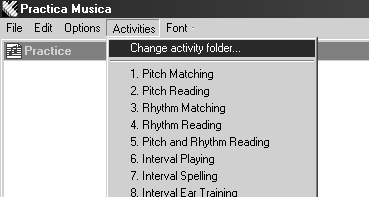Study Guide
Week 6
[ Reading ] [ Textbook ] [ Review ] [ New Material ] [ What You Should Know ] [ Homework ]
Textbook
Reading: pp. 90 - 105 in the textbook.
Do textbook activities 11.1 and 12.1. To get there in Practica Musica, change the activity folder to Textbook Activities:
The folder you want to change to is "Textbook Activities":
The activity folder you want now is Chapters 6-14:
Try activities 11.1 and 12.1. The first gives you a chance to try transposing themes, the second to hear how rounds sound.
Binary and ternary song forms
Binary song forms can be broken down into "A" and "B" sections, with a different melody in each, abbreviated as "AB" form. Often time each section is repeated ||: A :||: B ||
A ternary form has "A" and "B" sections like the binary form, except it returns to the "A" section again, resulting in an "ABA" form.
Of the four folk songs we looked at previously, Camptown Races is an example of a binary form. Down in the Valley is very short, but you could say that it is in binary form, with a short A followed by a short B.
Swanee River and Home on the Range are in ternary form. Swanee River has an "A" section that is repeated, then a "B", and then a return to the "A", for an "AABA" form.
See if you can guess what the form is for "Twinkle, Twinkle, Little Star", and then check your answer.
Review
Review chord progressions on the piano. Test your ears to see if you can identify chord progressions that use the I, ii, iii, IV, V, and vi chords.
New Material

Chords in open position
Chords in closed position have notes as close as possible to one another. Chords in open position have space between the notes. Chords of either type can be in root position or in inversion.
Schematic diagrams
With schematic diagrams you get a bigger perspective on a song. They show
- order of sections -- indicate above the section what type of section it is, i.e. "introduction", "verse", etc.
- length of sections by number of measures -- spread them out proportionately so that their width is representative of how long one section lasts compared to another
- details of instrumentation can be written underneath each section, showing what is different in the instruments that are used and how they are played
For example, a schematic diagram for a recording of "Stand By Me" might look like the following:
Intro Verse Chorus Verse -8- -16- -8- -16- bass, percussion add voice, organ, ac. guitar add strings background singer pad
Chorus Verse Chorus Chorus -8- -16- -8- -8- higher string line violins solo vocal back fade out What You Should Know
At the end of this week you should be able to:
Identify songs that have binary and ternary song forms.
Analyze chord functions in songs
Analyze song form using schematic diagrams
Read rhythms involving ties, dots, whole notes, half notes, quarter notes, eighths, and sixteenths. Be able to do through tape 36 on the Tap Machine
Recognize chords in open position
Recognize the sound of chord progressions involving the I, ii, iii, IV, V, and vi chords
Homework
Read pp. 90 - 105 in the textbook. Do textbook activities 11.1 and 12.1. To get there in Practica Musica, change the activity folder to Textbook Activities.
Download a copy of the accompaniment for "Take the 'A' Train" and save it in your st__ folder on the server. Enter your melody from the last assignment on the staff marked "Melody". Change the title and the composer to fit your piece. [ See a demonstration ]
Locate or construct a lead sheet of a song you would like to use for later exercises. It should include the melody, chord symbols, and lyrics. It should not include an accompaniment written out.
- Turn in a xerox copy of the lead sheet.
- Analyze the harmonic functions of your piece as best you can on the copy you are going to turn in. Put a "?" instead of a Roman numeral under any chord that you do not know how to analyze.
- On a separate piece of paper, create a schematic diagram of the form of the piece showing how many bars each section is. Above the bars give an indication of the type of section it is (i.e. introduction, verse, chorus, bridge, breakdown, ending, etc.). Try to find a recording of the piece, and include notations underneath the bars as to the kind of instrumentation and effects used (i.e. "piano and voice only", "add background voices", "heavy snare drum", "echo on electric guitar" ;).
©2001 Robert Willey


